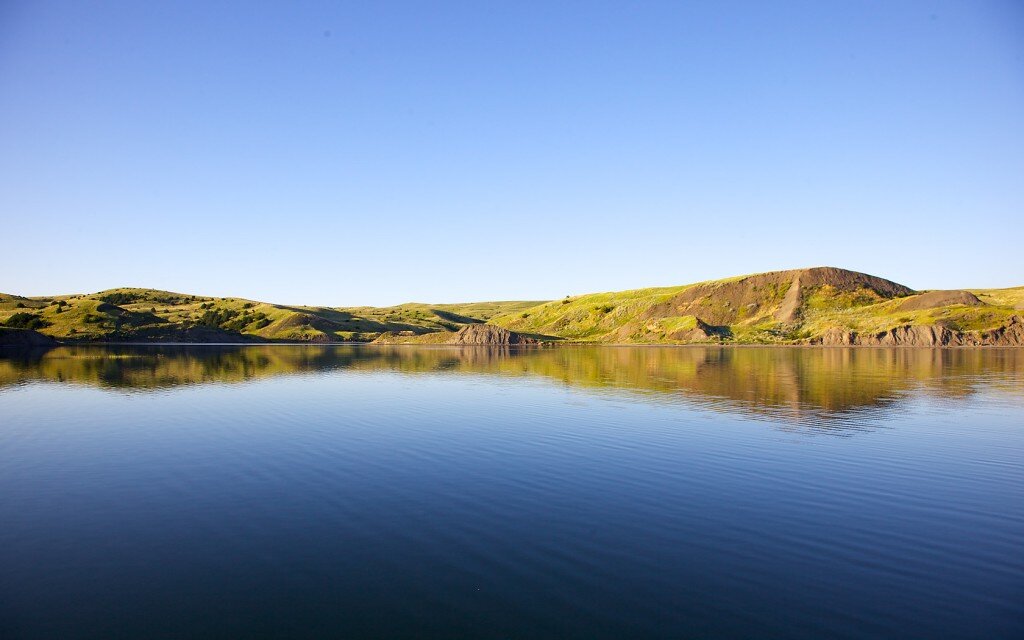Yesterday we were inside of the Notre Dame cathedral and today we have stepped outside and are looking at the west facade. More specifically we are looking at carvings next to one of the three sets of doors into the cathedral.The man holding his head is St. Denis. He became a saint in part because the miracle he performed was to be martyred by being beheaded, then to reach down and pick up his head and walk 6 miles north of Paris, preaching the whole way. He finally died. And they built a basillica to honor him. Not bad for a day's work.In researching this post I learned a new word: cephalophore. A cephalophore is someone who carries his/her own head. Try working that into your casual conversation today!
Bokeh
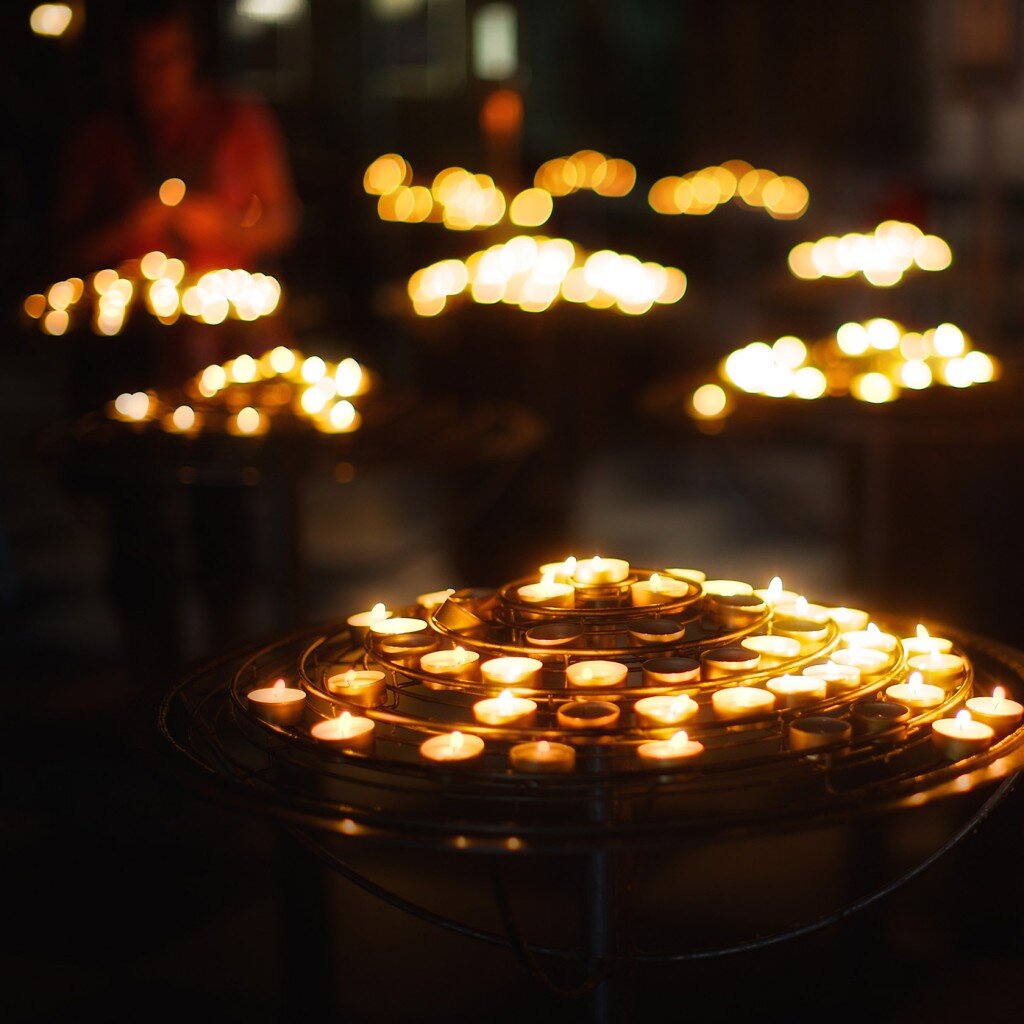 According to my Mac's built-in dictionary, bokeh is "the visual quality of the out-of-focus areas of a photographic image, especially as rendered by a particular lens." I've said it before about my Canon 50mm 1.2 and I'll say it again: this lens gives good bokeh.This photo was taken in the Notre Dame cathedral in Paris, France. My wife doesn't like it when I take photos of votives but I like having the chance to play with bokeh (and fire).
According to my Mac's built-in dictionary, bokeh is "the visual quality of the out-of-focus areas of a photographic image, especially as rendered by a particular lens." I've said it before about my Canon 50mm 1.2 and I'll say it again: this lens gives good bokeh.This photo was taken in the Notre Dame cathedral in Paris, France. My wife doesn't like it when I take photos of votives but I like having the chance to play with bokeh (and fire).
Three Tourists and One Local
 He has a gun, a big hat, a red uniform and isn't smiling. The three girls have cameras and casual clothes. So guest who the tourists are.Incidentally, I'm not sure if the soldier is a Beefeater or not. I also don't know what he's guarding. Perhaps an important door? Or maybe he's just a tourist attraction. Kind of like the giant tortoises at Reptile Gardens?
He has a gun, a big hat, a red uniform and isn't smiling. The three girls have cameras and casual clothes. So guest who the tourists are.Incidentally, I'm not sure if the soldier is a Beefeater or not. I also don't know what he's guarding. Perhaps an important door? Or maybe he's just a tourist attraction. Kind of like the giant tortoises at Reptile Gardens?
08-28-10 Open Shutters
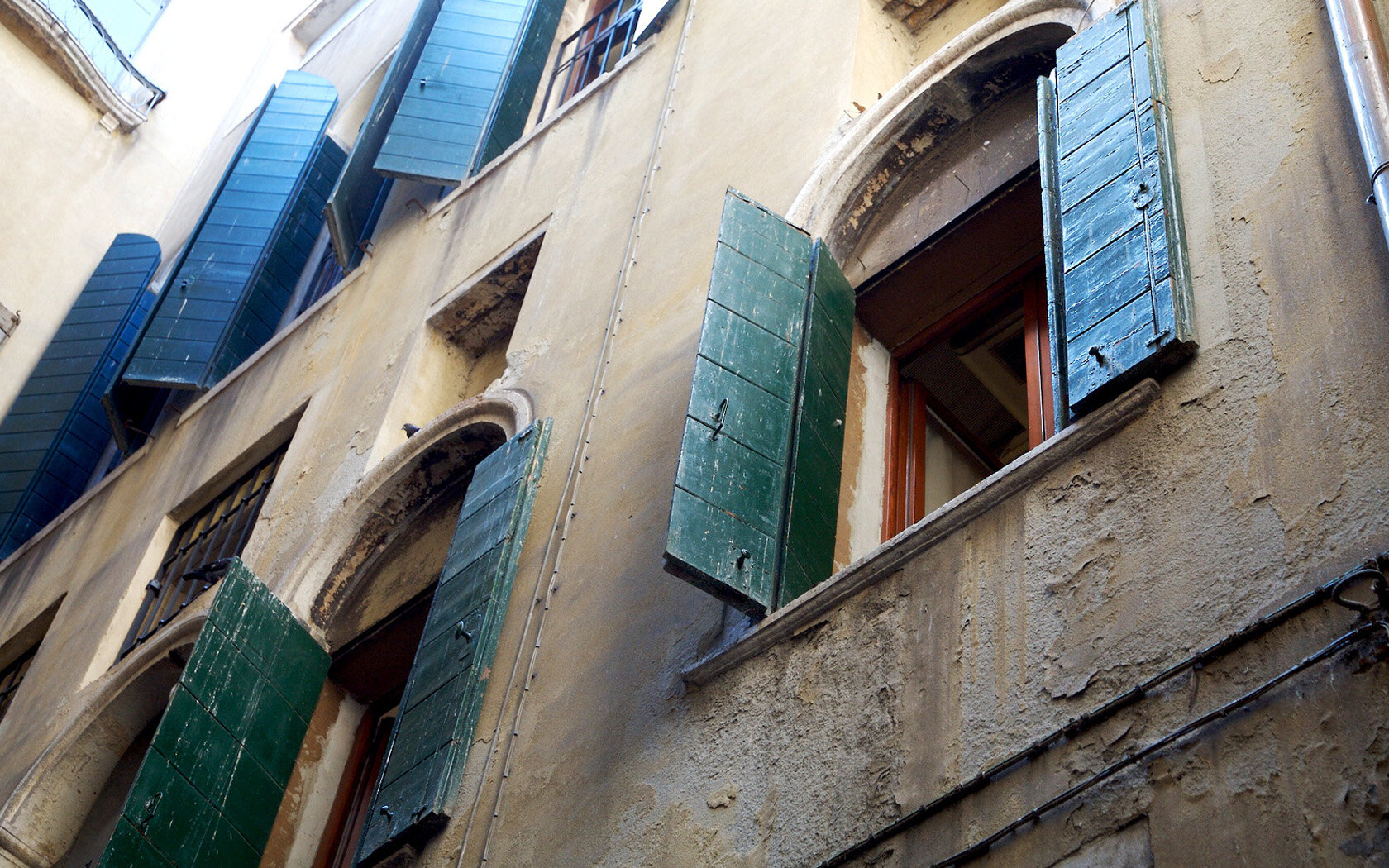 When I say, "Venetian," do you think of Las Vegas or of Italy? In the case of these open shutters, you should think of Venice, Italy. One clue is the benign decay you see in the masonry around the windows. Though I've never been to the Venetian Hotel in Las Vegas, I'm guessing it's not falling apart. Or sinking.
When I say, "Venetian," do you think of Las Vegas or of Italy? In the case of these open shutters, you should think of Venice, Italy. One clue is the benign decay you see in the masonry around the windows. Though I've never been to the Venetian Hotel in Las Vegas, I'm guessing it's not falling apart. Or sinking.
Filitosa - Corsica
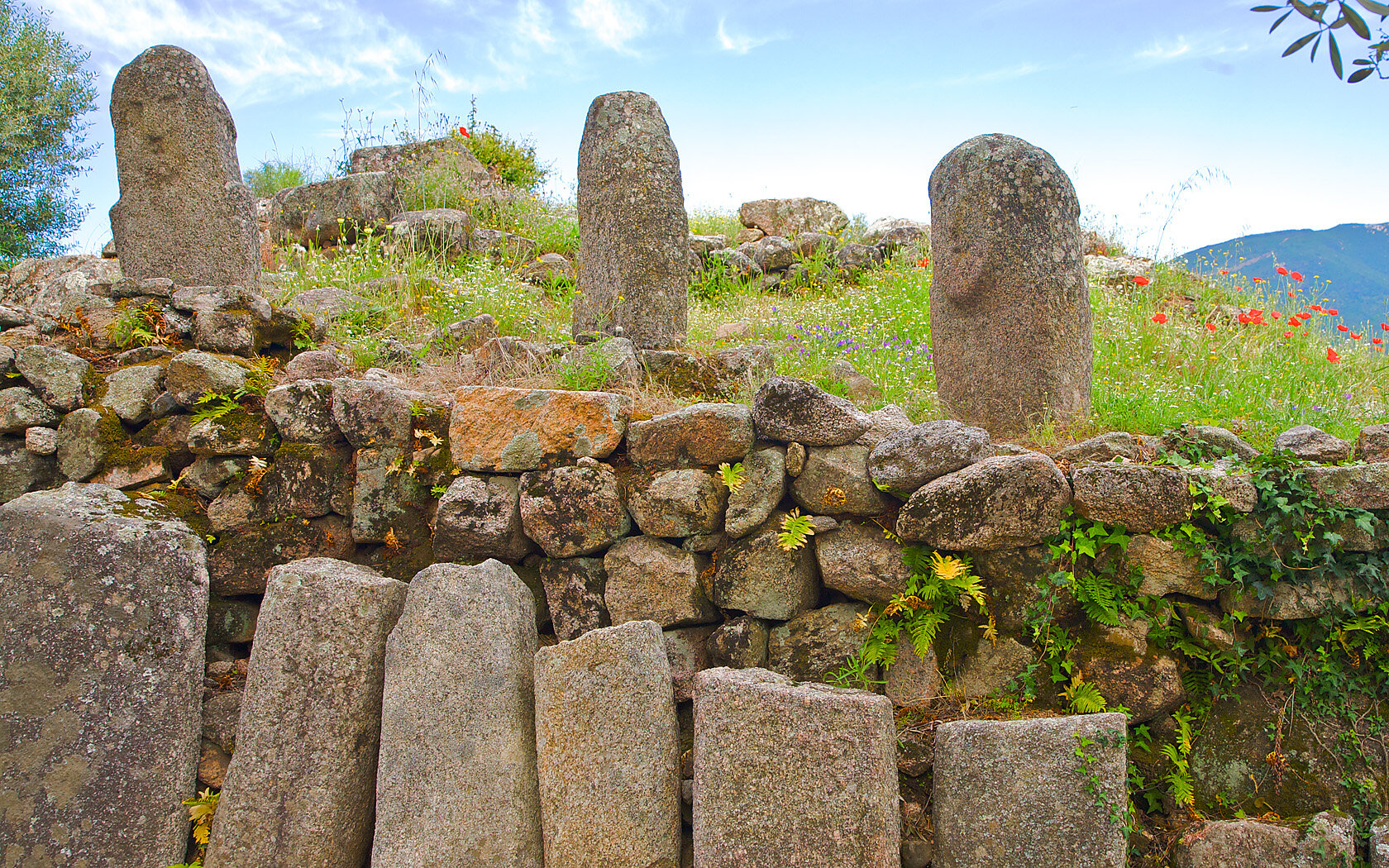 Filitosa is a historic site on the French island of Corsica. It was discovered in the 1940s and was determined to be a late neolithic settlement occupied from sometime around 3300 BC to 1500 BC. The stone columns in this photo are called menhirs and are thought to have been constructed to ward off enemies through magic.The day Deb and I visited Filitosa, which covers several acres and includes the quarry where the many structures and menhirs originated, we had the place to ourselves. We were certainly off the beaten path.One thing that strikes me about places like Filitosa is that it was inhabited for 1800 years. The town I live in has been inhabited for 125 years - less than 1/100 of Filitosa. I sometimes wonder what archaeologists will find in our location 1700 years from now. We have a clock tower. Will that survive? If it does, will they know what it was for? Magic?
Filitosa is a historic site on the French island of Corsica. It was discovered in the 1940s and was determined to be a late neolithic settlement occupied from sometime around 3300 BC to 1500 BC. The stone columns in this photo are called menhirs and are thought to have been constructed to ward off enemies through magic.The day Deb and I visited Filitosa, which covers several acres and includes the quarry where the many structures and menhirs originated, we had the place to ourselves. We were certainly off the beaten path.One thing that strikes me about places like Filitosa is that it was inhabited for 1800 years. The town I live in has been inhabited for 125 years - less than 1/100 of Filitosa. I sometimes wonder what archaeologists will find in our location 1700 years from now. We have a clock tower. Will that survive? If it does, will they know what it was for? Magic?
We Begin Again!
 Students return to the classroom in Watertown today and I can't wait to meet my sophomores. The girls in this photo aren't expressing exuberance for their return to school, however. This photo was taken of the 2005 homecoming parade. And, as seniors, they were pretty excited about that.Incidentally, if you are curious about the other blog entry for today, which I think shows up as a "Protected" entry, it is something I am doing for my world history students. So it is just for them. Sorry. I may share the final product with you if it turns out OK. :-)
Students return to the classroom in Watertown today and I can't wait to meet my sophomores. The girls in this photo aren't expressing exuberance for their return to school, however. This photo was taken of the 2005 homecoming parade. And, as seniors, they were pretty excited about that.Incidentally, if you are curious about the other blog entry for today, which I think shows up as a "Protected" entry, it is something I am doing for my world history students. So it is just for them. Sorry. I may share the final product with you if it turns out OK. :-)
Skeletons
08-25-10 We Trust You
 For the first 15 years I taught in my current school I had a key to my room but I didn't have a key to the building. No teacher did. The concern was that if one of us lost our key, the door would have to be re-keyed and a new set of keys would have to be distributed. What it meant was that if I wanted to work on a Saturday or Sunday or the evening, I would need to call my principal, go to his house, pick up the key. And then return it when I was done.I'll never forget the faculty meeting when our new principal said, "I have a gift for you." At that moment one of the assistant principals came in to the room with a giant key ring with 100 master keys on it. I was stunned. The long-time Spanish teacher sitting next to me literally squealed with joy.Oddly enough, in my career as an educator, which spans three decades, this is one of the most memorable things a principal has ever done for his or her staff. It was about empowerment, trust and autonomy.I am not saying that other principals I worked for didn't trust and empower me. They have. But If you ask me, public education is less about empowerment, trust and autonomy than it is about control. Public education is hierarchical, all the way from "No Child Left Behind" down to the way many teachers still arrange their classrooms. And I think all of this is a hindrance to the kind of learning and teaching processes that need to be occurring in 21st century schools.What is the "key" to improvement? I have some ideas but for me it will start tomorrow in my sophomore world history class when I outline what needs to be done this semester and then ask my students to help me figure out how we are going to do it.
For the first 15 years I taught in my current school I had a key to my room but I didn't have a key to the building. No teacher did. The concern was that if one of us lost our key, the door would have to be re-keyed and a new set of keys would have to be distributed. What it meant was that if I wanted to work on a Saturday or Sunday or the evening, I would need to call my principal, go to his house, pick up the key. And then return it when I was done.I'll never forget the faculty meeting when our new principal said, "I have a gift for you." At that moment one of the assistant principals came in to the room with a giant key ring with 100 master keys on it. I was stunned. The long-time Spanish teacher sitting next to me literally squealed with joy.Oddly enough, in my career as an educator, which spans three decades, this is one of the most memorable things a principal has ever done for his or her staff. It was about empowerment, trust and autonomy.I am not saying that other principals I worked for didn't trust and empower me. They have. But If you ask me, public education is less about empowerment, trust and autonomy than it is about control. Public education is hierarchical, all the way from "No Child Left Behind" down to the way many teachers still arrange their classrooms. And I think all of this is a hindrance to the kind of learning and teaching processes that need to be occurring in 21st century schools.What is the "key" to improvement? I have some ideas but for me it will start tomorrow in my sophomore world history class when I outline what needs to be done this semester and then ask my students to help me figure out how we are going to do it.
I Am Not the Artist
 If you think I did something beyond point and shoot on this photo, you'd be wrong. I credit Mother Nature. But my 70-200mm 2.8 lens played an important role.The circular green swirls that seem to frame these lilies are actually out-of-focus lilly leaves. And, like so many shots I take, I didn't see this until I opened the photo on my computer.These lilies are long gone now, I'm sad to say. In fact many of the flowers in my wife's garden are waning. Fall is just around the corner and, of course, it offers many opportunities for photographers.It's the four or five months of winter that I find challenging. . . .Canon 5DII 1/200s f/2.8 ISO400 130mm
If you think I did something beyond point and shoot on this photo, you'd be wrong. I credit Mother Nature. But my 70-200mm 2.8 lens played an important role.The circular green swirls that seem to frame these lilies are actually out-of-focus lilly leaves. And, like so many shots I take, I didn't see this until I opened the photo on my computer.These lilies are long gone now, I'm sad to say. In fact many of the flowers in my wife's garden are waning. Fall is just around the corner and, of course, it offers many opportunities for photographers.It's the four or five months of winter that I find challenging. . . .Canon 5DII 1/200s f/2.8 ISO400 130mm
Shipwreck
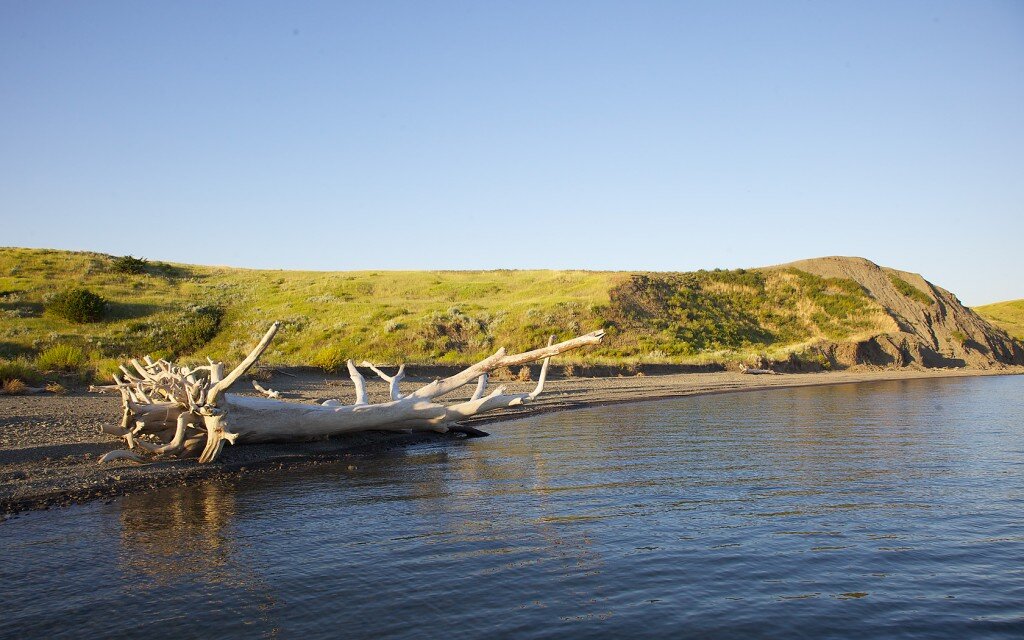 The shore and the land along Lake Oahe are relatively devoid of trees in the 20 mile stretch that I have sailed for two decades. But those who remember the river before the dam was built in the '40s and '50s will tell you that there were many trees.And then, when the water filled the massive reservoir, the trees died and ultimately floated to the surface. One local told me that when he sailed the lake in the early days, floating logs and beached driftwood were plentiful.A half century later, there is still evidence of what the Missouri River used to be, including this massive, ancient cottonwood. The tree is bleached white from thousands of sunny days and I can only guess at its story. Was it a sappling in 1804 when Lewis and Clark led their expedition through the newly acquired Louisiana Purchase? Who knows? The tree isn't talking. . .The title is figurative, of course. As far as I know, there are no real shipwrecks on Lake Oahe.
The shore and the land along Lake Oahe are relatively devoid of trees in the 20 mile stretch that I have sailed for two decades. But those who remember the river before the dam was built in the '40s and '50s will tell you that there were many trees.And then, when the water filled the massive reservoir, the trees died and ultimately floated to the surface. One local told me that when he sailed the lake in the early days, floating logs and beached driftwood were plentiful.A half century later, there is still evidence of what the Missouri River used to be, including this massive, ancient cottonwood. The tree is bleached white from thousands of sunny days and I can only guess at its story. Was it a sappling in 1804 when Lewis and Clark led their expedition through the newly acquired Louisiana Purchase? Who knows? The tree isn't talking. . .The title is figurative, of course. As far as I know, there are no real shipwrecks on Lake Oahe.
Imminence - Sunrise, August 21, 2010
 I had spent Friday, August 20, 2010, making small repairs to Wandering Star and then sailing, motoring and swimming on a hot, August day on Lake Oahe. Deb drove out from Watertown after work and arrived around 8 PM. I said, "We're going to Hurricane Bay." Because the wind had died to whisper, we motored west a few miles and dropped our anchor in a narrow, protected channel of the bay. We were alone. On this clear, warm evening it seemed like we had the bay, the lake and a billion stars all to ourselves.The next morning, we woke up well before sunrise and around 6:30 we pulled up anchor and motored out into the main channel to watch the sunrise. The weather forecast said it was going to get to 100 degrees Fahrenheit on this day. But in the pre-dawn moments, it was beautiful. And just as the sun started to light up a band of clouds close to the horizon, I took this photo.Yes, it's "just another sunrise shot" but like my "just another sunset shot" from several weeks ago, there is much more here than meets the eye: I was with my favorite person on my favorite boat in one of my favorite places. Some would call central South Dakota on a 100+ degree day "god-forsaken." I would say that you must have your senses shut down if you aren't seeing god here - especially in a beautiful, quiet sunrise like this.(See this on Panoramio.)
I had spent Friday, August 20, 2010, making small repairs to Wandering Star and then sailing, motoring and swimming on a hot, August day on Lake Oahe. Deb drove out from Watertown after work and arrived around 8 PM. I said, "We're going to Hurricane Bay." Because the wind had died to whisper, we motored west a few miles and dropped our anchor in a narrow, protected channel of the bay. We were alone. On this clear, warm evening it seemed like we had the bay, the lake and a billion stars all to ourselves.The next morning, we woke up well before sunrise and around 6:30 we pulled up anchor and motored out into the main channel to watch the sunrise. The weather forecast said it was going to get to 100 degrees Fahrenheit on this day. But in the pre-dawn moments, it was beautiful. And just as the sun started to light up a band of clouds close to the horizon, I took this photo.Yes, it's "just another sunrise shot" but like my "just another sunset shot" from several weeks ago, there is much more here than meets the eye: I was with my favorite person on my favorite boat in one of my favorite places. Some would call central South Dakota on a 100+ degree day "god-forsaken." I would say that you must have your senses shut down if you aren't seeing god here - especially in a beautiful, quiet sunrise like this.(See this on Panoramio.)


